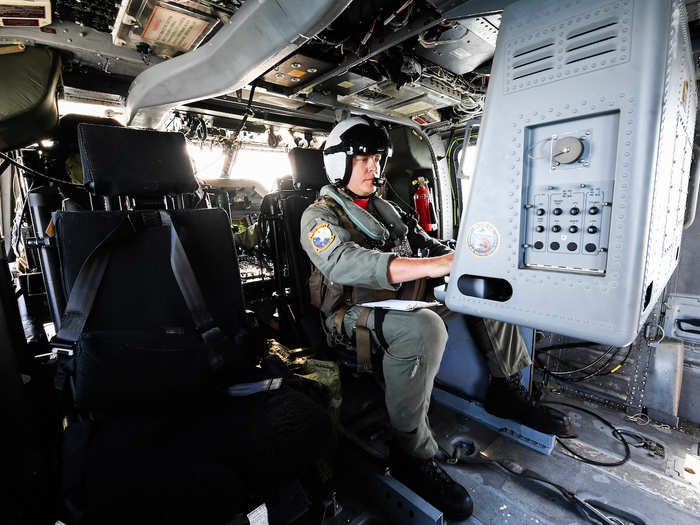- Home
- slideshows
- miscellaneous
- During major war games in Europe, the US Navy is practicing to 'up the game' against one of its biggest threats
During major war games in Europe, the US Navy is practicing to 'up the game' against one of its biggest threats
Recent mine-countermeasures development has focused on unmanned underwater vehicles — so new that the technology tested at BaltOps had never been used in the Baltic before.

Researchers from the Navy's Office of Naval Research and German Naval Research, as well as US Naval Forces Europe and US 6th Fleet command staffs, took a German research ship out to experiment with Mk 18 Mod 2 UUVs.

The Mk 18 Mod 2 UUVs being tested had two kinds of sensor packages: The Small Synthetic Aperture Minehunter and the Autonomous Topographic Large Area Survey forward-looking sonar.

Small Synthetic Aperture Minehunter systems work on a range of wavelengths, providing fine-grain imaging of the seafloor and of small man-made objects as well as peering into the seabed to provide imagery and analysis of buried objects.
The SSAM II module used at BaltOps "provides higher resolution and is intended to hunt bottom mines," said Navy Lt. Matthew Stroup, public affairs officer for the BaltOps 2019 Mine Warfare Task Group.
SSAM II "has two modes; linear [synthetic aperture sonar] mode for rapid search and circular SAS, which provides very high-resolution images to enable" reacquiring and identification, Stroup added.
Autonomous Topographic Large Area Survey forward-looking sonar, known as ATLAS, has a wide search-area width that's meant for volume mine-hunting, Stroup said. It can also be used to gather information, including mapping of clutter and large-object detection on the seafloor and to gauge ocean depth.
Mine warfare is key to maintaining sea lines of communications, particularly in ports and landing areas, said US Navy Rear Adm. Scott Robertson.

Robertson is commander of the Naval Surface and Mine Warfighting Development Center and led the BaltOps 2019 Mine Warfare Task Group.
Working with partners and allies to exercise "those skills, refine doctrine and tactics, techniques, and procedures, and to experiment with new technology keeps us stronger together," Robertson said.

"It is great seeing US [mine countermeasures] UUV capabilities performing efforts in my home region," German Bundeswehr Senior Chief Nico Bermann said. "This, tied together with the data gathering and shown interoperability, will benefit future mine countermeasure exercises."
!["It is great seeing US [mine countermeasures] UUV capabilities performing efforts in my home region," German Bundeswehr Senior Chief Nico Bermann said. "This, tied together with the data gathering and shown interoperability, will benefit future mine countermeasure exercises."](https://staticbiassets.in/thumb/msid-69882450,width-700,height-525,imgsize-543203/it-is-great-seeing-us-mine-countermeasures-uuv-capabilities-performing-efforts-in-my-home-region-german-bundeswehr-senior-chief-nico-bermann-said-this-tied-together-with-the-data-gathering-and-shown-interoperability-will-benefit-future-mine-countermeasure-exercises-.jpg)
The BaltOps 2019 Mine Warfare Task Group didn't limit itself to surface operations. US Navy Helicopter Sea Combat Squadron 28 worked from Germany's Hohn Air Base to bring the Airborne Laser Mine Detection System and Airborne Mine Neutralization System—Archerfish to the Baltic for the first time.

ALMDS and AMNS-AF are both mounted on the MH-60S Sea Hawk helicopter. The former uses a laser-imaging system to detect and identify mines at the surface or just below the waves. The latter's Archerfish system is a mine neutralizer that uses sonar and video to find mines and fire a warhead with a shaped charge to destroy them.

"This is a real opportunity to up the game from an airborne mine countermeasures perspective," said Vice Adm. Andrew Lewis, commander of 2nd Fleet. "We have not done this kind of thing in a long time. There is a lot that we can learn in the theater on both the capability side and on the exercise side. But it starts by being in the region—you have to do it here."

And the mine-countermeasures task force did do it there—albeit against a much older version of the threat.

During the exercise, German, Norwegian, Danish, and US sailors tracked down three WWII-era mines on the seafloor in German waters.

Norwegian specialists first found and identified two mines, which Danish divers then reacquired and identified. Norwegian divers found the other mine in another training area. All three were British air-laid A Mk I–VI mines, each weighing about 1,000 pounds.

"Working together...to clear these undetonated, historical mines provides hands-on training and increases safety to mariners in the region," Robertson said.

"There is a good chance we will find more of these mines as the exercise continues, and it’s reassuring to know our international task group has the training and expertise necessary to safely dispose of them," Robertson added.

Popular Right Now
Popular Keywords
Advertisement